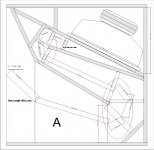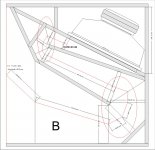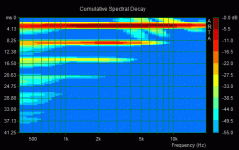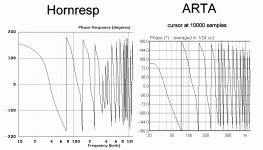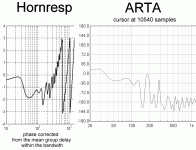Hi David_Web,
You did .
.
Not true - at the time, I had no idea how to export a wave sound file. Jean-Michel came to the rescue though .
.
As a general principle, I prefer to use modal forms rather than allowing multiple windows to be accessed. The only exception is the Hornresp Help file form.
Sorry - that would require too much work .
.
Thanks for the feedback. I am sure that Jean-Michel will be pleased to see that his method is working well.
That is intentional.
Kind regards,
David
David_Web said:Thanks! (I thought I bugged you about that).
You did
David_Web said:Now I know that when you say "no can do" you really mean "shh, don't ruin the surprise".
Not true - at the time, I had no idea how to export a wave sound file. Jean-Michel came to the rescue though
David_Web said:But would it be possible to have any popup windows not block the movement of the parent window?
And also to keep IR window open and then update it.
As a general principle, I prefer to use modal forms rather than allowing multiple windows to be accessed. The only exception is the Hornresp Help file form.
David_Web said:Hmm, maybe the ability to break out response windows for easier viewing.
Sorry - that would require too much work
David_Web said:I have already played around with the IR export function and listened to the simulation for the TH I built (or close enough at least) and it works really well.
The frequency response also models like it should when run through the IR.
Thanks for the feedback. I am sure that Jean-Michel will be pleased to see that his method is working well.
David_Web said:btw now the IR is always calculated with resonances not masked.
That is intentional.
Kind regards,
David
Re: Re: Re: Re: Re: Hornresp export to Akabak
Hi Don,
Me too . The interesting thing is, in this particular case there is an inconsistency in AkAbak itself. A duct closed at one end is treated differently to a waveguide closed at one end. Using node 0 with a waveguide generates an error message.
. The interesting thing is, in this particular case there is an inconsistency in AkAbak itself. A duct closed at one end is treated differently to a waveguide closed at one end. Using node 0 with a waveguide generates an error message.
Kind regards,
David
Don Hills said:I just tend to notice things like this.
Hi Don,
Me too
Kind regards,
David
fb said:Is there a guide somewhere to modelling OS waveguides?
Hi fb,
Not that I am aware of.
Press the 'O' key when the L12 input text box has the focus to select "Obl" for an oblate spheroidal waveguide.
The Horn Segment Wizard can be quite useful when working with OS waveguides.
Kind regards,
David
"As a general principle, I prefer to use modal forms rather than allowing multiple windows to be accessed"
Sometimes I find that hornresp covers the data I need when entering driver data meaning I have to close the dialog to move hornresp out of the way. It's fine the way it is but I thought it might be easier to work with.
"Sorry - that would require too much work ."
."
I knew it!
"Jean-Michel came to the rescue though ."
."
"I am sure that Jean-Michel will be pleased to see that his method is working well."
Thanks! It works great.
Now I just have to keep modeling to get the best IR I can.
Ill have to measure the IR of the TH I built and see if it looks similar.
When not using damping in a box I get excessive odd ringing of sort, not a problem per see but a little annoying when you want to model a BR and then get a proper IR of it. Will damping and port be separate in the future?
btw I still think damping creates odd phase and GD shifts. Try a way to small box for a driver, the GD will see a smooth hump at resonance as it should, now add some damping and you get sharp corners and a less wide hump. Not affected by stuffing density.
Sometimes I find that hornresp covers the data I need when entering driver data meaning I have to close the dialog to move hornresp out of the way. It's fine the way it is but I thought it might be easier to work with.
"Sorry - that would require too much work
I knew it!
"Jean-Michel came to the rescue though
"I am sure that Jean-Michel will be pleased to see that his method is working well."
Thanks! It works great.
Now I just have to keep modeling to get the best IR I can.
Ill have to measure the IR of the TH I built and see if it looks similar.
When not using damping in a box I get excessive odd ringing of sort, not a problem per see but a little annoying when you want to model a BR and then get a proper IR of it. Will damping and port be separate in the future?
btw I still think damping creates odd phase and GD shifts. Try a way to small box for a driver, the GD will see a smooth hump at resonance as it should, now add some damping and you get sharp corners and a less wide hump. Not affected by stuffing density.
B is what I use (as I read in MJK's papers)palesha said:For measuring the horn length, which is the proper/better method in the drawings A & B of the same box.
The Box B is in the next post
David McBean said:
Hi fb,
Not that I am aware of.
Press the 'O' key when the L12 input text box has the focus to select "Obl" for an oblate spheroidal waveguide.
The Horn Segment Wizard can be quite useful when working with OS waveguides.
Kind regards,
David
Thanks David
Is there anything particular to enter for driver params? (for compression drivers)

palesha said:For measuring the horn length, which is the proper/better method in the drawings A & B of the same box.
The Box B is in the next post
Did you use any specific sofware to produce these drawings?
Eva :
Did you use any specific sofware to produce these drawings?
I used Coreldraw for this drawing.
Very user friendly & easy to use.
Hi David_Web,
Sorry, no.
I agree .
.
Kind regards,
David
David_Web said:Will damping and port be separate in the future?
Sorry, no.
David_Web said:I still think damping creates odd phase and GD shifts.
I agree
Kind regards,
David
fb said:Is there anything particular to enter for driver params? (for compression drivers)
Hi fb,
Compression driver electro-mechanical parameters are no different to those of any other driver. Finding the necessary values though, can be a bit difficult as this information is not normally released by the manufacturer.
Kind regards,
David
Hello David,
I just tried the new version of Hornresp and I am happy about how the pulse reponse operates. Everyone can now import the wave file in an audio analysis software.
As an example I imported in ARTA the pulse response resulting from the simulation of a TD2001 mounted on a 1 meter long tube and ARTA gave me the CSD you can see in attached file.
Do you think it could be intersting to allow to export the .wav for directivity angles different than 0° (on axis)?
BTW: you still have to improve the phase presentation, as it is very difficult to see the small variation of phase due to a change in an input parameter. ;-)
Best regards from Paris, France,
Jean-Michel Le Cléac'h
I just tried the new version of Hornresp and I am happy about how the pulse reponse operates. Everyone can now import the wave file in an audio analysis software.
As an example I imported in ARTA the pulse response resulting from the simulation of a TD2001 mounted on a 1 meter long tube and ARTA gave me the CSD you can see in attached file.
Do you think it could be intersting to allow to export the .wav for directivity angles different than 0° (on axis)?
BTW: you still have to improve the phase presentation, as it is very difficult to see the small variation of phase due to a change in an input parameter. ;-)
Best regards from Paris, France,
Jean-Michel Le Cléac'h
Attachments
Hi Jean-Michel,
Thanks for confirming that everything is working as it should, and thanks again for providing the necessary algorithms!
The on-axis restriction could certainly be removed if you think it would be a worthwhile enhancement.
Can I assume that showing "corrected" phase would overcome the problem? .
.
Kind regards,
David
Jmmlc said:I just tried the new version of Hornresp and I am happy about how the pulse response operates. Everyone can now import the wave file in an audio analysis software.
Thanks for confirming that everything is working as it should, and thanks again for providing the necessary algorithms!
Jmmlc said:Do you think it could be interesting to allow to export the .wav for directivity angles different than 0° (on axis)?
The on-axis restriction could certainly be removed if you think it would be a worthwhile enhancement.
Jmmlc said:You still have to improve the phase presentation, as it is very difficult to see the small variation of phase due to a change in an input parameter.
Can I assume that showing "corrected" phase would overcome the problem?
Kind regards,
David
Re: Impulse Response
Hi Oliver,
Welcome back .
.
Kind regards,
David
tb46 said:Just back from a trip, and found the newest version of Hornresp. Again a big improvement, thank you.
Hi Oliver,
Welcome back
Kind regards,
David
Hello David,
May be you should ask the readers on DIYAudio what they think about the use of a phase curve corrected by a delay.
For loudspeaker measurement generally we introduce an arrival time in order to limit the number of -pi/+pi wrappings.
The equivalent within Hornresp could be a phase correction by a linear phase equivalent to the mean group delay inside the bandwith.
To help the discussion in that message you'll find the phase curve as given at the moment by Hornresp and by ARTA when importing the pulse reponse from Hornresp and setting the cursor at the exact middle of the signal window (sample N° 10 000).
As you see the phase curves are nearly identical (another proof of how good is the export pulse response function).
In a second message I'll show the same phase curve but adding a delay.
Best regards from Paris, France.
Jean-Michel Le Cléac'h
May be you should ask the readers on DIYAudio what they think about the use of a phase curve corrected by a delay.
For loudspeaker measurement generally we introduce an arrival time in order to limit the number of -pi/+pi wrappings.
The equivalent within Hornresp could be a phase correction by a linear phase equivalent to the mean group delay inside the bandwith.
To help the discussion in that message you'll find the phase curve as given at the moment by Hornresp and by ARTA when importing the pulse reponse from Hornresp and setting the cursor at the exact middle of the signal window (sample N° 10 000).
As you see the phase curves are nearly identical (another proof of how good is the export pulse response function).
In a second message I'll show the same phase curve but adding a delay.
Best regards from Paris, France.
Jean-Michel Le Cléac'h
David McBean said:Can I assume that showing "corrected" phase would overcome the problem?.
Kind regards,
David
Attachments
Hello
Attached to this message you'll see, on left, a first graph showing the phase curve given by Hornresp but corrected by the mean group delay within the bandwith.
On right you'll see the phase curve given by Arta when the cursor is set at sample 10540.
In both case it seems to me that we can see more easily some phase variations which are difficult to see in the original phase curves.
Best regards from Paris, France
Jean-Michel Le Cléac'h
Attached to this message you'll see, on left, a first graph showing the phase curve given by Hornresp but corrected by the mean group delay within the bandwith.
On right you'll see the phase curve given by Arta when the cursor is set at sample 10540.
In both case it seems to me that we can see more easily some phase variations which are difficult to see in the original phase curves.
Best regards from Paris, France
Jean-Michel Le Cléac'h
Attachments
- Home
- Loudspeakers
- Subwoofers
- Hornresp
